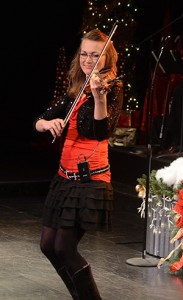It’s a hackneyed line: What is the difference between a fiddle and a violin?
The question came up because one of the selections at this Saturday’s Pops concert with Symphony of the Hills is the Charlie Daniels string-burner The Devil Went Down To Georgia. Not your usual symphony fare, but fair game for a Pops concert.
I asked four musicians who play both. Not surprisingly, they gave four different answers.
Gale Reddick fiddles 25 hours a day. He was my very first fiddle teacher, sold me my first violin, and gave me my first lesson. (My kids have never forgiven him.)
“They say the difference is that a violinist carries his violin in a case, and a fiddler carries his in a tow sack.” He laughed. “Or a violin is a fiddle that’s been domesticated.”
But some fiddlers don’t think it’s funny.
“It is the same instrument, but it can be a touchy thing,” he said. “Many musicians I’ve met say don’t call my violin a fiddle, or don’t call my fiddle a violin.”
Reddick believes there are three parts to music: rhythm, melody, and harmony. One of those is the key to differentiating the sound of a fiddle.
“It’s the rhythm that makes the style, always. Take any song by the Beatles, Duke Ellington, Leonard Bernstein. You can change the melody and harmony, but it is the rhythm that makes the difference between the styles.”
Another of my patient music teachers took a stab at the question. Theresa Britt teaches a stage-ful of string students, leads the Fredericksburg Community Orchestra, and fiddles with the Rockbox Theater. She also plays violin with Symphony of the Hills, and will be one of the dueling fiddlers.
“You really have to experiment with the violin to find that fiddle sound,” she said. “On a piece like Orange Blossom Special you can slide and noodle around. Fiddling requires a lot more experimentation because you are looking for a particular sound.”
Bart Trotter is a World Champion fiddler who spent several years playing around Fredericksburg. He always knew he wanted to be a fiddler, but the path to fiddle perfection was through his school orchestra. As a lad, he could not always see the value in staying in the school band.
“I was still in orchestra but playing and winning fiddle contests all over,” Trotter said. He was going to quit, and told another fiddle player so. “I told him that they showed me how to play this thing, so now I’m going to quit and do my own thing.”
That “other fiddler” happened to be virtuoso Mark O’Conner. “He told me, man, as long as you can get that free training, stay with it. He is the one who talked me into not quitting orchestra.”
Trotter, who is now based in Branson, did point out some of the differences in how fiddlers set up their instruments.
Most classical players tend to play with good strings, with a slightly higher bridge. Fiddlers use fiddle strings, and like to lower the action, thereby allowing them to reach more notes quicker. Some even use “cross tuning” or changing the pitch of certain strings in order to create a certain fiddle sound. But otherwise, “it’s all the same.”
“There is absolutely no difference,” said Trotter. “It is just the music you play on it.”
Finally, Gene Dowdy, who will be dueling with Britt at the Symphony concert, when asked the difference between violin and fiddle, came up with the absolute best answer: The clothes.
“Think about it,” he said. “The fiddle is the same exact instrument you play in an orchestra or mariachi band. The only difference is what clothes you are wearing when you play it.”
I remember being backstage at an accordion festival where three musicians stood around one accordion. When the guy in the charro outfit picked it up, it sounded like mariachi; when the swamper played it, it came out Cajun; and when the guy in lederhosen squeezed it, out came polka. One instrument; three outfits; three kinds of music.
When performing in or conducting one of three orchestras, Dowdy wears a tuxedo. When he fiddles in the bluegrass/Americana group Down For the Count, he sports blue jeans and a floppy brown hat.
“There’s not a nickel’s worth of difference in the instrument,” he said. “It’s really just the music, the style, the way you play. It’s stylistic things, like doing double stops and the shuffle beat.”
So, there. A violin is a fiddle. A fiddle is a violin. And what about the purists who think the twain should never meet?
“Hey, we live in Texas!” said Britt. “If you live in Texas you gotta have a fiddle in the orchestra.”
